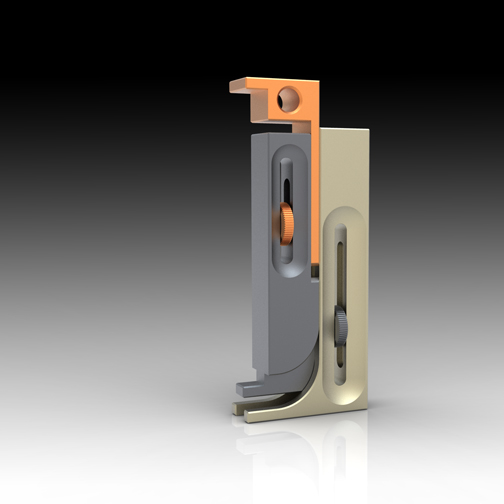Well, here is a new fascinating gizmo, sure to peak your interest. Yes, it is functional… Yes Megan Fox has one pre-ordered–she’s no dummy but you might be if you can’t figure this out.
You know you want it.
This is… The Tool That Cannot Be Denied!

And the answer is?
Oh, and for all those anal retentive types; yes, this is 100% anatomically correct. Sad to say. Sorta.
–John
PS: Don’t you think it is cool to proffer an image of a woodworking tool that nobody ever thought of before or would ever want? Me too! And who would dare say such things without issues?
That would be me.
And I need to deal with it.
But then again, who cares.
Oh, that would be me…
–John

It’s the inverse kerfmaker. Instead of subtracting the width of the kerf from the cut, it adds it. Thus, if you already have a dado or other slot, you can cut a piece that will be a snug fit.
Steve:
Are you married? Because if you are, Megan Fox wants you to call…
The number you ask (and all for all the other perverts that follow my worthless blog? Try 911)
Oh, that aside, you are warm…please explain how your theory applies…
And should you be correct, please share how, for the sake of mankind, why this is an important invention, sure to be the scorn of of the internet and if you don’t believe me, just wait.
So let’s pretend…if you are right, SPECIFICALLY describe your wild ass assumption based upon sound guesstimate theory…
XXXOOO John
It’s a “kerftaker”!
– Peter
Peter:
Do you really want me to share this lame ass answer with your students?
Thought so.
Look forward to dinner tomorrow…
XXXOOO
John
Its a tenon gauge. The three prongs at the bottom are used to measure the width of the mortise, the cut is made then you measure the length and set the gauge and cut. That is my guess anyway.
The initials when the mouse hovers over the photo gives a hint……
It’s a combination height gauge and kerfmaker.
The larger foot with its slot allows a blade to pass beneath.
Laid on its side, it’s a kerfmaker.
More function in the same space.
Megan must be so proud!
John,
Reminds me of the lyrics of that ’80s song by Pat Benatar. “You’re a Kerfmaker, Kerftaker, don’t mess around with me.” So my lame ass answer to the question I wasn’t asked is: it does both! Set the kerf and then put the piece you want to make a groove for in one place, or the groove you want to fill in the other and cut away! Oh, it probally can be used to set the pitch on the main rotor too! And finally it gives some pathetic souls something to complain about or a way to waste two days replicating one!
-Rutager
John,
You first close it up like you do with the kerfmaker, then perform the same kind of calibration adjustment using a test cut and the orange locknut. Next, you insert the three-fingered end into the slot whose width you want to gauge, slide the fingers apart until they’re snug in the slot, and tighten the gray locknut. At this point, the distance between the end of the orange piece and the end of the body is the width of the slot plus the width of the kerf of your saw.
So, you now have a two-position stop, as with the kerfmaker, but in this case intended for ripping rather than crosscutting. Set your rip fence to the “larger” stop setting, and take your first cut to remove the waste on the outboard (away from the fence) side. Then set the rip fence to the “smaller” stop setting, and take your second cut. The width of the piece on the outboard side now equals the width of your original slot.
You can use this to cut a tenon from a mortise, as Ray mentions above, for a lap joint like with the kerfmaker (except that you gauge the tongue from the slot, rather than the other way around), etc. Basically, you can use it just about any place where you have an existing groove or slot, and you want to cut a piece to fit that slot.
The one thing I don’t like about the model as shown is the extra ear on the end of the orange piece. While this does let the device stand upright on its end, it gets in the way of measuring slots that aren’t near the edge of the board (e.g., a dado for a shelf). Maybe some kind of flip-down stop instead?
As for why this is such an important invention, well, I divulged the details in my call to Megan, but I’m afraid I’m under an NSA/CIA/FBI NDA, so I really can’t say anything more here.
Steve;
Let’s pretend you are correct.
I’m guessing the extra ear is a standoff so the tool can be used as a flip-stop without canting. Yes/No?
One more thing–STAY AWAY FROM MEGAN!
–John
John,
Yes, I noticed after I posted that my wording was incorrect; I said “…stand upright on its end,” but I really meant “…stand upright on its side.” The ear on the orange piece balances the measuring ears at the other end.
As for Megan, I was just returning one of her many, many calls. My voice mail box fills up faster than I can empty it.
John,
Can we assume that this is long awaited KerferDude or Reznairous?
John,
A question of scale.
Can you post a pick with a quarter next to it,
or the dimensions of the base as it’s sitting on the horizontal surface?
Or the scale in relation to the KM-1?
Call it a reality check.
Nice to have you back.
Roger